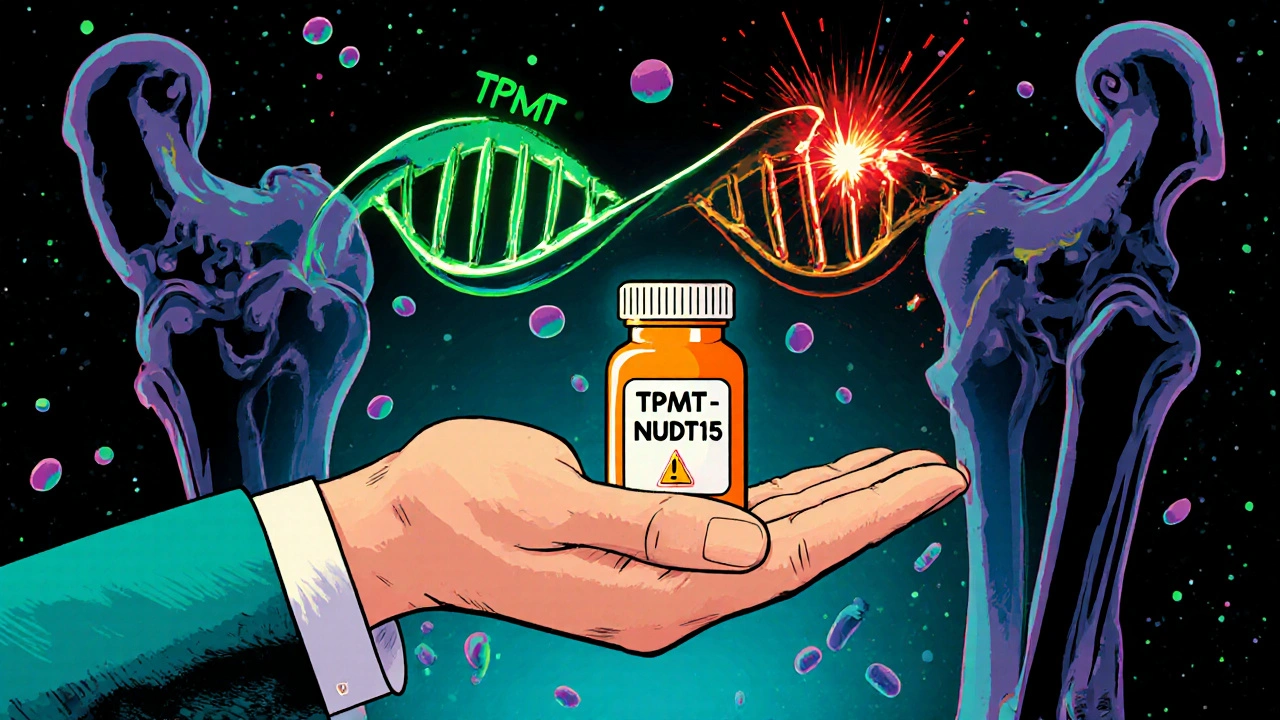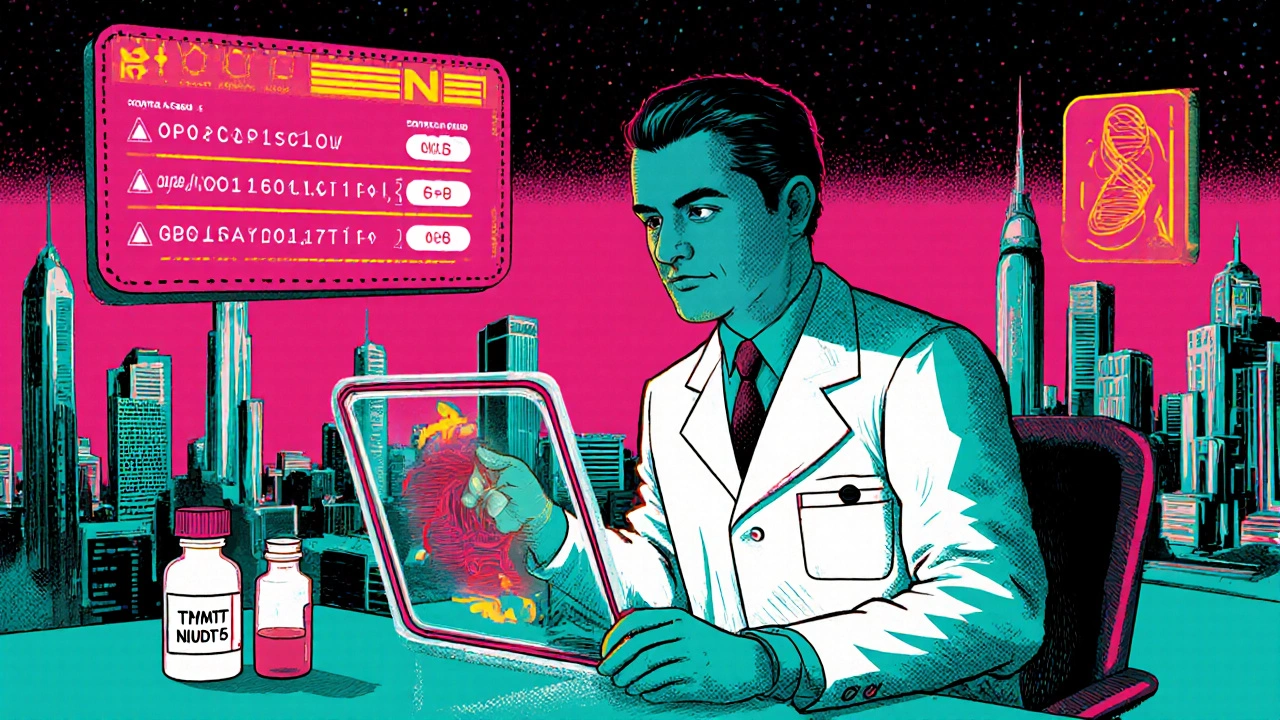Azathioprine and TPMT Testing: How Genetic Screening Prevents Life-Threatening Side Effects

TPMT Dosing Calculator
Determine Your Azathioprine Starting Dose
Based on TPMT genetic testing results, this tool helps determine the appropriate starting dose of azathioprine to minimize serious side effects.
Your recommended starting dose:
Important: This calculator is based on TPMT testing only. For comprehensive risk assessment, NUDT15 testing is recommended for people of Asian descent. Always consult your doctor for personalized medical advice.
Key Information
- Standard dose 1.5-2.5 mg/kg/day
- Intermediate dose 30-70% of standard dose
- Severe deficiency Avoid azathioprine
When you’re prescribed azathioprine for Crohn’s disease, lupus, or after a transplant, you’re not just taking a pill-you’re trusting your body to handle a powerful drug that can save your life… or nearly end it. About 1 in 300 people have a hidden genetic flaw that turns this medication into a poison. That’s where TPMT testing comes in-not as a luxury, but as a necessary safety check before the first dose.
What Azathioprine Does-and Why It’s Dangerous for Some
Azathioprine has been used since the 1960s to calm down overactive immune systems. It works by slowing down white blood cells that attack your own tissues. For people with inflammatory bowel disease, rheumatoid arthritis, or organ transplants, it’s often the only affordable long-term option. A month’s supply costs between $20 and $50, compared to biologics that run $1,500 per dose.
But here’s the catch: your body breaks down azathioprine using an enzyme called TPMT. If your TPMT enzyme doesn’t work well, the drug builds up in your bone marrow and starts destroying your blood cells. This isn’t a mild side effect-it’s myelosuppression, a condition where your body stops making enough red blood cells, white blood cells, and platelets. Without treatment, it can lead to fatal infections, uncontrolled bleeding, or severe anemia.
Studies show that 15% to 28% of people on azathioprine have side effects. Nausea is common, but the scary ones-low white blood cell counts, liver damage, pancreatitis-are rare and often avoidable.
What Is TPMT Testing and Why It Matters
TPMT testing checks your genetic makeup to see how well your body processes azathioprine. About 10% of people in the U.S. have one faulty copy of the TPMT gene (heterozygous). They can still take the drug, but they need a lower dose-usually 30% to 70% less than standard. About 0.3% of people (1 in 300) have two faulty copies (homozygous). For them, azathioprine is dangerous. Even a tiny dose can cause life-threatening drops in blood counts.
Testing can be done two ways: genotyping (looking at your DNA for specific gene variants like *2, *3A, *3B, *3C) or phenotyping (measuring enzyme activity in your blood). Genotyping is more reliable because it’s not affected by recent blood transfusions or other drugs.
But here’s the truth: TPMT testing doesn’t catch everything. About 1 in 10 patients who have serious side effects on azathioprine have normal TPMT levels. That’s because another gene-NUDT15-is now known to cause similar problems, especially in people of Asian descent. Up to 20% of Asian populations carry a NUDT15 variant that makes them extremely sensitive to azathioprine. That’s why modern guidelines now recommend testing for both TPMT and NUDT15 together.
What the Guidelines Say-and What Doctors Actually Do
The Clinical Pharmacogenetics Implementation Consortium (CPIC) has clear rules: if you’re homozygous for TPMT deficiency, don’t use azathioprine at all. Use methotrexate or another drug instead. If you’re heterozygous, start at 30% to 70% of the normal dose and check your blood count every week for the first month. If you’re normal, you can start at full dose-but still monitor closely.
The American Gastroenterological Association (AGA) says TPMT testing should be done before starting azathioprine. The European Crohn’s and Colitis Organisation (ECCO) says it’s “recommended,” not mandatory. Why the difference? Cost and access.
In U.S. academic hospitals, about 50% to 60% of patients get tested. In Europe, it’s closer to 80%. But in community clinics and non-gastroenterology practices? Often, no one checks. Some doctors assume the risk is low. Others don’t have quick access to testing. And some patients can’t afford the $200 to $400 test, even though most commercial insurers cover it.
One study of 333 patients found that genotyping didn’t reduce overall side effects-because most side effects happen in people with normal TPMT levels. But it did catch the one patient with homozygous deficiency who would’ve had a near-fatal drop in blood cells. That’s the real win: preventing the worst-case scenario.

What TPMT Testing Won’t Prevent
TPMT testing is not a magic shield. It doesn’t protect you from:
- Drug interactions-especially with allopurinol (used for gout). Even if your TPMT is normal, mixing it with azathioprine can cause severe toxicity.
- Liver damage-about 7.4% of patients develop elevated liver enzymes. This has nothing to do with TPMT. It’s linked to high levels of a metabolite called 6-MMP.
- Other genetic factors-like GST variants that affect how your body handles toxins.
- Random reactions-some people just develop pancreatitis or severe nausea for no clear reason.
One patient on Reddit said: “My TPMT was normal. I got liver failure anyway.” Another said: “I had low TPMT, started on half dose, and stayed healthy while my friend on full dose had to quit.” Both are true.
That’s why every patient on azathioprine needs regular blood tests-no exceptions. A complete blood count (CBC) every week for the first month, then every 2 to 3 months after that. Liver function tests too. TPMT testing tells you your starting risk. Blood tests tell you what’s actually happening in your body.
What to Do If You’re Starting Azathioprine
If your doctor prescribes azathioprine, ask these five questions:
- Will you test my TPMT and NUDT15 genes before I start?
- If I have low TPMT, what’s the alternative? (Methotrexate, 5-ASA, or biologics?)
- What dose will I start with, and how will it be adjusted?
- Will I need weekly blood tests for the first month?
- Should I avoid allopurinol, NSAIDs, or ACE inhibitors while on this drug?
If your doctor says, “We don’t do that here,” ask for a referral to a specialist or a pharmacy that offers pharmacogenomic services. Many hospitals now have clinical pharmacists who specialize in this.
Don’t assume you’re safe just because you feel fine. The first sign of myelosuppression is often fatigue or a low-grade fever-symptoms you might blame on stress or a cold. By the time you feel really sick, your white blood cell count could already be dangerously low.

The Bigger Picture: Pharmacogenomics Is Here to Stay
Azathioprine and TPMT testing is one of the oldest, most proven examples of personalized medicine. It’s not futuristic-it’s everyday practice in top hospitals. The FDA updated the drug label in 2019 to include information about both TPMT and NUDT15. Companies like OneOme and GeneSight now offer multi-gene panels that include both tests.
But adoption is still uneven. In low-income areas, patients often start azathioprine without testing and pay the price later-through hospital stays, missed work, or worse. The cost of testing ($200-$400) is tiny compared to the cost of treating a life-threatening blood disorder.
For now, if you’re taking azathioprine-or planning to-don’t skip the test. It doesn’t guarantee you won’t have side effects. But it gives you the best chance to avoid the worst ones.
What Else Should You Know?
Azathioprine can make your skin more sensitive to sunlight. Wear sunscreen and cover up when outside. It can also raise your risk of skin cancer over time-so get regular skin checks.
And if you’re pregnant or planning to be: talk to your doctor. Azathioprine is considered relatively safe during pregnancy for IBD patients, but you need close monitoring.
This isn’t about fear. It’s about control. You’re not just a patient. You’re someone who deserves to know how your body will react before you swallow a pill that could change everything.
Is TPMT testing required before taking azathioprine?
No, it’s not legally required, but major medical guidelines from the American Gastroenterological Association and CPIC strongly recommend it. Many hospitals and specialists do it as standard practice. Skipping it puts you at higher risk for severe side effects, especially if you have a hidden genetic deficiency.
Can I take azathioprine if my TPMT test shows low activity?
If you have intermediate (heterozygous) TPMT activity, yes-but you’ll need a lower starting dose, usually 30% to 70% of the standard amount. If you have severe (homozygous) deficiency, you should avoid azathioprine entirely. Your doctor will likely switch you to methotrexate or another immunosuppressant to avoid life-threatening blood cell loss.
Does NUDT15 testing replace TPMT testing?
No. NUDT15 testing complements TPMT testing. TPMT is most relevant for people of European descent, while NUDT15 variants are more common in Asian populations. Experts now recommend testing for both genes together, especially if you have Asian ancestry. One without the other leaves you vulnerable to unexpected toxicity.
How long does TPMT testing take and how much does it cost?
Most tests take 3 to 7 days to return results. The cost ranges from $200 to $400 in the U.S. Most private insurers cover it, but Medicaid coverage varies. Some pharmacies or hospitals offer the test as part of a broader pharmacogenomic panel, which may be more cost-effective if you’re on multiple medications.
If I have normal TPMT, am I completely safe on azathioprine?
No. Normal TPMT doesn’t protect you from liver damage, pancreatitis, or other side effects. About 10% of people who stop azathioprine due to side effects have normal TPMT levels. That’s why regular blood tests-CBC and liver function-are mandatory for everyone on the drug, no matter what your genes say.
Can I get tested for TPMT and NUDT15 without a prescription?
In most cases, no. These are clinical genetic tests that require a doctor’s order. Direct-to-consumer tests like 23andMe don’t test for TPMT or NUDT15 variants. Even if you have raw DNA data, interpreting it correctly requires clinical context. Always work with a healthcare provider who understands pharmacogenomics.

stephen riyo
November 26, 2025 AT 01:37So let me get this straight-you’re telling me I could’ve died from a $20 pill because my doctor didn’t run a $300 test? And now I’m supposed to be grateful they didn’t kill me? I’ve been on this stuff for 3 years. My CBC was fine. My liver was fine. I felt fine. So why didn’t they test me? Because it’s "not mandatory"? That’s not medicine-that’s Russian roulette with a prescription.
Damon Stangherlin
November 26, 2025 AT 18:32Hey, I just want to say thank you for writing this. I had a bad reaction last year-low WBC, fever, spent a week in the hospital. Turns out I’m heterozygous for TPMT. I was on full dose. If I’d known sooner, I could’ve avoided all that. Now I get tested before every new med. It’s not expensive, it’s not hard-it’s just common sense. Please, if you’re on azathioprine, ask for the test. Your bone marrow will thank you.
vikas kumar
November 26, 2025 AT 22:52I’m from India, and I’ve seen this firsthand. My cousin took azathioprine for lupus-normal TPMT, but NUDT15 positive. He got pancreatitis within two weeks. No one here even talks about NUDT15. Doctors still think it’s just a Western thing. We need more awareness in Asia. The gene variants are common here. Testing should be standard, not optional. It’s not about money-it’s about not killing people with outdated assumptions.
Vanessa Carpenter
November 28, 2025 AT 06:36My mom’s on it for RA. She’s 72. Her doctor said, "You’re fine, just monitor." She didn’t even know what TPMT was until I showed her this post. Now she’s getting tested next week. I’m glad someone finally said it out loud. This isn’t hype-it’s basic care.
Bea Rose
November 28, 2025 AT 12:09TPMT testing doesn’t prevent side effects. It prevents one type of side effect. That’s it. The rest? Still happening. So stop acting like it’s a magic bullet. It’s not. Blood tests are still mandatory. Always.
Michael Collier
November 28, 2025 AT 19:18It is imperative to underscore that pharmacogenomic screening constitutes a critical component of evidence-based clinical practice in the context of immunosuppressive therapy. The Clinical Pharmacogenetics Implementation Consortium guidelines are not merely recommendations-they represent the current standard of care. Failure to adhere to these protocols may constitute a deviation from accepted medical norms.
Shannon Amos
November 30, 2025 AT 16:29So the doctor says "we don’t do that here" and you’re supposed to just… nod and take the pill? Cool. I’ll just wait until my blood cells start disappearing, then sue everyone. Because apparently, in 2024, we still treat genetic risk like a suggestion.
Wendy Edwards
November 30, 2025 AT 21:53I’m so glad I found this. My sister got hospitalized because they didn’t test her. She’s 28. She’s fine now, but she lost three months of work. I cried reading this. My dad’s a nurse-he said they used to just wing it. But now? We’re getting tested. Every time. No excuses. I wish I’d known this sooner. Please, if you’re reading this and you’re on azathioprine-ask. Ask. Ask. Don’t wait until it’s too late.
Dan Rua
December 2, 2025 AT 02:14Just got my TPMT/NUDT15 results back-normal for both. Still doing weekly CBCs. Just because you’re not genetically cursed doesn’t mean you’re immune. I’m taking this seriously. Thanks for the reminder. 😊
Amanda Meyer
December 2, 2025 AT 20:17It is concerning that cost and access continue to dictate clinical decision-making in pharmacogenomics. While the financial burden of testing is minimal relative to the cost of adverse event management, systemic disparities in healthcare delivery prevent equitable implementation. This is not merely a clinical oversight-it is a structural failure.
Jesús Vásquez pino
December 3, 2025 AT 13:25Why are we even doing this? Why not just ban the drug? It’s dangerous. It’s old. It’s not like we don’t have better options. Why are we still forcing people to gamble with their bone marrow because someone in the 60s thought it was a good idea?
hannah mitchell
December 4, 2025 AT 15:25My doctor tested me. I’m heterozygous. Started at 40% dose. Been on it for 18 months. No issues. I’m just glad I didn’t go full dose like my friend did. He’s off it now. I didn’t even know this was a thing until I read this. Thanks for the heads-up.
Mqondisi Gumede
December 5, 2025 AT 12:52